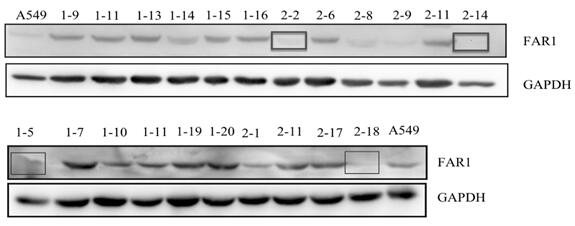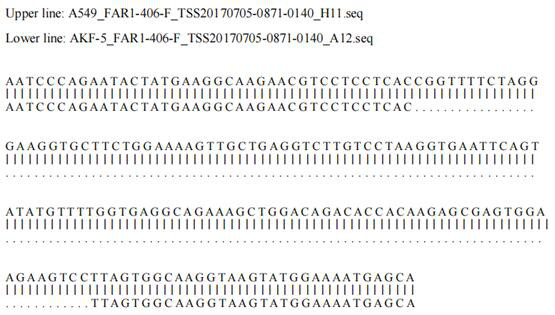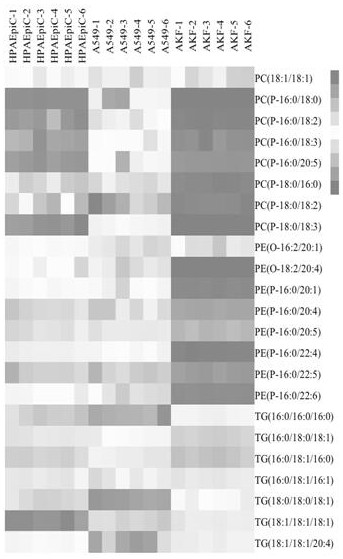New application of FAR1 gene
A FAR1, gene expression technology, applied in the field of medicine, can solve problems such as unclear molecular mechanism
- Summary
- Abstract
- Description
- Claims
- Application Information
AI Technical Summary
Problems solved by technology
Method used
Image
Examples
Embodiment 1
[0023] Example 1: Construction of FAR knockout plasmid
[0024] CRISPR / Cas9 is an adaptive immune defense formed by bacteria and archaea during the long-term evolution to defend against invading viruses and foreign DNA. Microorganisms integrate the invading DNA sequences into their own genomes, and when they are invaded again, they cut the DNA or RNA of viruses, etc., so as to resist the invasion of viruses. In recent years, CRISPR / Cas9 has been humanized for gene editing, which provides new solutions for the treatment of diseases by performing specific DNA modifications on targeted genes. CRISPR (ClusteredRegularly Interspaced Short Palindromic Repeat) requires two parts when editing genes: Cas9 nuclease and gRNA, of which Cas9 nuclease has been integrated into commercial vectors, while gRNA is an important component of the CRISPR knockout system part. There is an RNA sequence of about 20 nt in the CRISPR sequence that targets the target gene. Cas9 and gRNA combine to form ...
Embodiment 2
[0041] Example 2: Construction of FAR1 gene knockout stable cell line
[0042] 1. Select A549 cells with the highest substitution number and in good condition and inoculate them in a 6-well plate to ensure that the cell density is about 75% after 24 hours. Use RPMI-1640 medium containing only 10% fetal bovine serum at 37°C, 5% CO 2 cultured in a cell incubator;
[0043] 2. Before transfecting the plasmid, wash the cells with sterile 1×PBS, add Optim medium, and transfect 1.2 μg plasmid per well. In addition, transfect the PX459 plasmid with unlinked sgRNA as a negative control (while maintaining the total amount of transfected plasmid). Under the premise of the mass of 1.2 μg, the two groups of sgRNAs were mixed together and transfected into A549 cells), and after 6 h of transfection, the medium was changed to a complete medium containing serum but no antibiotics to continue the culture;
[0044] 3. After 24 hours of transfection, the cells were transferred into a 100mm cell...
Embodiment 3
[0073] Example 3: Non-targeted lipid metabolomics detection experiment
[0074] 1) Prepare cells: A549 lung adenocarcinoma cells, AKF cells, and normal alveolar epithelial cells HPAEpic in good condition with a cell density of about 95% (guaranteed that the amount of cells per dish is ≥ 10) 7 1 cells), and washed twice with 1×PBS, collected the cells into a 2 mL centrifuge tube with a cell scraper, centrifuged to remove the supernatant, and stored the cell pellet in liquid nitrogen;
[0075] 2) Take 100mg of sample and put it in a 5mL centrifuge tube, add 1.5mL of chloroform-methanol-water mixture (2:2:1, -20°C), and add 5 steel balls;
[0076] 3) Put the sample into the high-throughput tissue grinder and process it at 60Hz for 1.5min;
[0077] 4) Let the sample stand on ice for 30min, add 0.38mL of pure water, vortex for 30s, and place on ice for 10min;
[0078] 5) Centrifuge at 12000r for 5min at room temperature, and take 600μL of the lower layer in a new 2mL centrifuge t...
PUM
 Login to View More
Login to View More Abstract
Description
Claims
Application Information
 Login to View More
Login to View More - R&D
- Intellectual Property
- Life Sciences
- Materials
- Tech Scout
- Unparalleled Data Quality
- Higher Quality Content
- 60% Fewer Hallucinations
Browse by: Latest US Patents, China's latest patents, Technical Efficacy Thesaurus, Application Domain, Technology Topic, Popular Technical Reports.
© 2025 PatSnap. All rights reserved.Legal|Privacy policy|Modern Slavery Act Transparency Statement|Sitemap|About US| Contact US: help@patsnap.com



